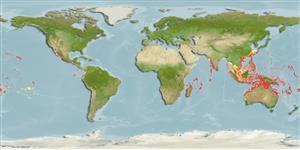>
Mulliformes (Goatfishes) >
Mullidae (Goatfishes)
Etymology: Parupeneus: Latin, parum, parvum = small + Peneus, the name of a river.
More on author: Lacepède.
Environment: milieu / climate zone / depth range / distribution range
Ecologia
marinhas associadas(os) a recifes; intervalo de profundidade 2 - 91 m (Ref. 26165), usually 2 - 40 m (Ref. 37816). Tropical; 30°N - 30°S
Indo-Pacific: western Indian Ocean to the Line, Marquesan, and Tuamoto islands, north to southern Japan, south to Australia and Rapa. Replaced by Parupeneus porphyreus in the Hawaiian Islands (Ref. 37816).
Tamanho / Peso / Idade
Maturity: Lm ? range ? - ? cm
Max length : 38.0 cm TL macho/indeterminado; (Ref. 9710); peso máx. publicado: 2.3 kg (Ref. 4887)
Espinhos dorsais (total): 8; Raios dorsais (total): 9; Espinhos anais 1; Raios anais : 7. Diagnosis: Pectoral rays 15 (rarely 14 or 16); gill rakers 6-8 + 23-27 (total 30-34); body depth 2.93.5 in SL; head length (HL) 2.85-3.25 in SL; dorsal profile of snout straight to slightly concave, the snout length 1.85-2.1 in HL; barbels short, 1.5-1.8 in HL; longest dorsal spine 1.55-1.9 in HL; last dorsal ray slightly longer than penultimate ray; posterior margin of caudal-fin lobes convex; pectoral-fin length 1.35-1.55 in HL; pelvic-fin length 1.2-1.55 in HL. Color brown to red dorsally, paler ventrally, the scale edges darker; scales on body with or without a white or pale blue spot; a darker brown or brownish red stripe, broadly bordered in white, from front of snout through center of eye, becoming indistinct below origin of second dorsal fin; a dark brown spot within stripe behind eye; a second dark stripe across cheek parallel to the first, bordered below by a white band that ends at pectoral-fin base; a white or pale pink spot anteriorly on upper half of caudal peduncle covering about three horizontal rows of scales, followed by a black or dusky spot with darker scale edges a little larger in size (spot may extend slightly below lateral line); fins light red to reddish gray, the second dorsal and anal fins often with small pale spots (Ref. 54393).
Occurs in seagrass beds and coralline areas of lagoon and seaward reefs. Feeds on benthic invertebrates, mostly crustaceans, at night.
Ciclo de vida ou comportamento de acasalamento
Maturidade | Reprodução | Desova | Ovos | Fecundidade | Larvas
Randall, J.E., 2004. Revision of the goatfish genus Parupeneus (Perciformes: Mullidae), with descriptions of two new species. Indo-Pac. Fish. (36):64 p. (Ref. 54393)
Status na Lista Vermelha da UICN (Ref. 130435)
Ameaça para os humanos
Harmless
Uso pelos humanos
Pescarias: espécies comerciais; peixe esportivo: sim
Mais informação
Nomes comunsSinônimosMetabolismoPredadoresEcotoxicologiaReproduçãoMaturidadeDesovaAgregação de desovaFecundidadeOvosDesenvolvimento dos ovos
ReferênciasAquaculturaPerfil para aquaculturaEstirpesGenéticaElectrophoresesHereditariedadeDoençasProcessamentoNutrientsConversão de massa
Ferramentas
Relatórios especiais
Baixar XML
Fontes da internet
Estimates based on models
Preferred temperature (Ref.
123201): 24.3 - 28.9, mean 27.6 °C (based on 1374 cells).
Índice de diversidade filogenética (Ref.
82804): PD
50 = 0.5000 [Uniqueness, from 0.5 = low to 2.0 = high].
Bayesian length-weight: a=0.01096 (0.00700 - 0.01716), b=3.13 (3.00 - 3.26), in cm total length, based on LWR estimates for this species & Genus-body shape (Ref.
93245).
Nível Trófico (Ref.
69278): 3.5 ±0.0 se; based on diet studies.
Resiliência (Ref.
120179): médio(a), tempo mínimo de duplicação da população 1,4 - 4,4 anos (Preliminary K or Fecundity.).
Fishing Vulnerability (Ref.
59153): Low to moderate vulnerability (28 of 100).
Nutrients (Ref.
124155): Calcium = 30.8 [15.8, 68.0] mg/100g; Iron = 0.299 [0.152, 0.660] mg/100g; Protein = 17.9 [14.5, 20.9] %; Omega3 = 0.127 [0.073, 0.231] g/100g; Selenium = 58.4 [28.6, 132.5] μg/100g; VitaminA = 190 [39, 787] μg/100g; Zinc = 0.52 [0.31, 0.99] mg/100g (wet weight);
